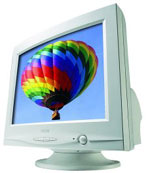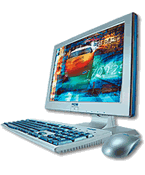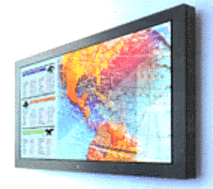CRT stands for Cathode Ray Tube and is the most the common type of displays. They are found in different technologies, such as Invar and Trinitron. Trinitron or aperature grill monitors are vertically flat, whereas some standard "flat-screen" monitors may curve slightly vertically and horizontally. The annoying thing about aperture grill technology is the thin black lines that you'll see when viewing a white background. The lines run horizontally and are necessary for a sharper image. 15" Trinitron monitors have one line near the bottom third of the monitor, and 17", 19", and 21" Trinitron monitors have two lines. You'll only notice these lines when viewing bright, same-color screens, such as a document in a word processor, but they can be annoying.
TOP

Using LCD (Liquid Crystal Display) technology, the flat panel monitors are light, flat and giving a "softer" displays. TFT is the most expensive display of this type. They are found in better grade laptops, and are available also for use with desktop PCs. In 2001 the prices have dropped significantly. The current price is in excess of $800 for a 17.3" flat panel monitor. The flat panel monitors is also called a "soft" screen, since the images appear softer than from Cathode Ray Tubes.
TOP

Plasma technology owes a debt to the fluorescent lamp. Two glass panels, only 0.1mm apart, each with its own electrodes, make up the plasma display. Gas is injected between the panels, and becomes charged when voltage is applied to the electrodes. This "plasma phenomenon" generates ultraviolet rays which strike the red, green and blue phosphors, to create the image you see. Plasma screens have a viewing angle of 160 degrees, which in plain English means that if you look at it from the side, you see a good clear image. LCD screens vary in quality but most do not give a good image unless you look straight at them. They is very noticeable on notebook computer screens. Plasma technology is also unaffected by magnetic fields unlike CRT technology used in normal computer monitors.
TOP
